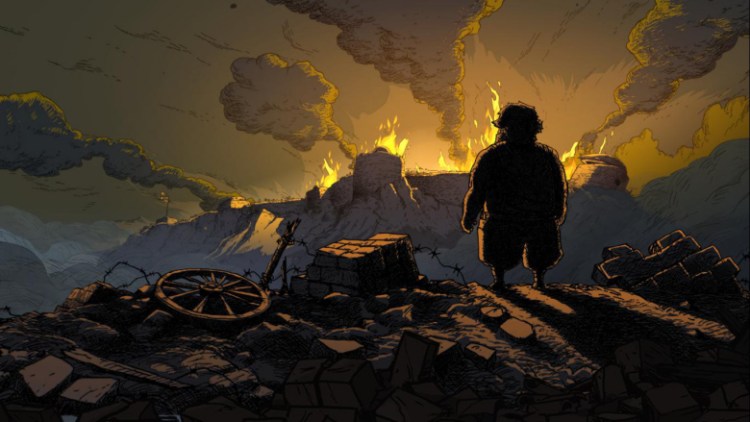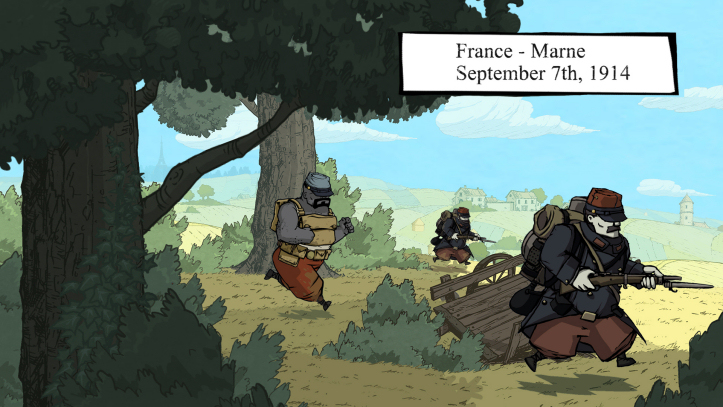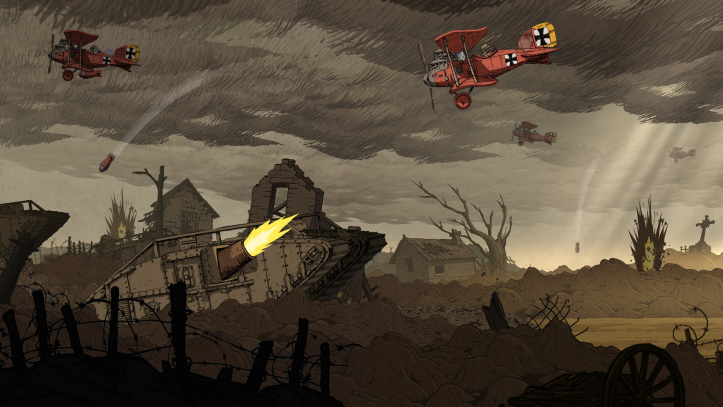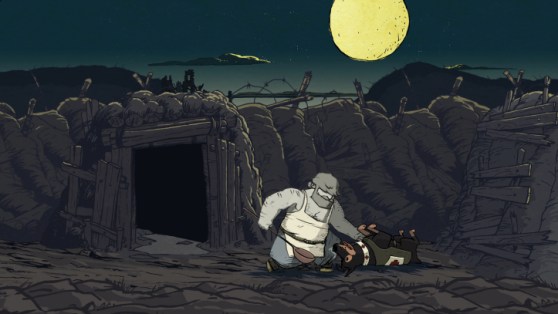Check out our Reviews Vault for past game reviews.
History was always my least favorite subject in school. Facts and dates bore me, so when Ubisoft Montpellier’s Valiant Hearts: The Great War began tossing out historical trivia about the first World War for me to pause and read, I promptly ignored it.
That is, until the story actually got me to care.
The cartoonish puzzle-adventure game (for PlayStation 4, Xbox One, PlayStation 3, Xbox 360, PC, iOS) doesn’t force you to read information about World War I — not unless you want to pore through the unlockable collection of events and memorabilia. Instead, it puts you on the frontlines in a reenactment of various battles, taking you from muddy trenches to underground tunnels to ravaged cities and war camps, all vulnerable to enemy attack at any moment.
What you’ll like
Daily life of a soldier
Spanning 1914 to 1918, Valiant Hearts follows the intersecting stories of four characters in Europe: a French war veteran named Emile; his German son-in-law, Karl; an American named Freddie; and a medic, Anna. Their paths keep crossing, and more than once, they save each other’s life.
The experience is as much about them as it is about the nameless characters they fight beside. The war is inescapable. As you charge through enemy fire, your fellow soldiers die around you. One step too late, and you would have caught the same bullet or stepped on the same mine. It’s a powerful message.
Valiant Hearts doesn’t linger on these deaths. Doing so would mean stopping amid the chaos — the cannon blasts and sniper fire that push you onward — which would cost you your life. You notice when people fall, though, sometimes dozens in minutes. It’s hard not to consider yourself lucky.
When you’re not running, you’ll do a lot of assembling parts for machines, digging through earth and rubble, cutting barbed wire, throwing bombs to knock away debris, and helping people in trouble. If you find what they want, such as a tool or clean pair of socks, or rescue someone in need, they’ll often give you what you need to move forward. Only on occasion will you complete more complex puzzles like rerouting deadly gas-spewing pipes or solving a safe combination. Few games can take that kind of mundanity and attach so much tension and meaning to it. Failing to act could mean the end for you and others, but so can following orders.
Expressive moods of battle
As much as Valiant Hearts is about death, it’s a beautiful game. Ubisoft Montpellier’s illustrative style contains a ton of detail, but the colors are what makes it truly special. You feel the arduous months pass as the weather changes. Rain patters off turrets, winter arrives, or stormy clouds cover the sky. Even on the sunniest afternoons, the mood can be grim as civilians call out for help or cry for their loved ones.
You never forget that you’re at war. In the multiple layers of background, you can see for miles the effects of destruction: barren trees and wastelands, ruined buildings, and billows of green, poisonous gases. Death is everywhere.
For as bleak as it can be, Valiant Hearts isn’t above a little optimism and humor — especially in its occasional boss battles, which are Hollywood popcorn-movie ridiculous. Freddie is a beefy American who plays fisticuffs with the elusive villain Baron Von Dorf, who attacks from his zeppelin or a mighty tank. As Emile, I laughed as I ran around whacking things with a soup ladle, which I had inexplicably hung onto. This is not a depressing game, but it never fails to communicate the brutalities of war — amputation, starvation, disease, and even mutiny.
The cutest dog of war
Taking a note from Call of Duty: Ghosts, Valiant Hearts’ canine star makes the game infinitely better. Freddie and Emile, the two characters you’ll spend the most time with, befriend a medic dog that proves invaluable in the trenches. On the PC, you can give him commands by holding Left Alt and pressing one of the numbers that appears onscreen near items or locations. He can crawl through holes, wiggle under dangerous obstacles, or fetch an out-of-reach set of keys, for example. The controls are easy and intuitive.
And, well, he’s adorable. I smiled every time my character petted him or rubbed his belly as a reward.
More than ‘duck and cover’ tactics
Stealth is a weird thing in non-stealth games. Developers too often mishandle it. In a way, stealth is a big part of Valiant Hearts, whether you’re dodging gunfire or hiding from authorities.
One of my favorite scenes in the game is a stealth sequence where one of the characters escapes from a POW camp at night. Taking cover isn’t always as simple as hiding behind bushes. It involves tiptoeing behind a moving flock of sheep or sprinting in pitch darkness — silhouettes visible against the dark-blue background — stopping only when flares whiten the sky and illuminate the many enemies nearby.
Just like with sneaking around, I lost track of how many times I turned a gear, pushed a lever, or threw an explosive. Valiant Hearts impressed me with how well it managed to make those actions feel different each time. Digging is completely new, for example, when you’re not only shoveling around unexploded missiles but also racing to get clear of a deadly bombing from above.




